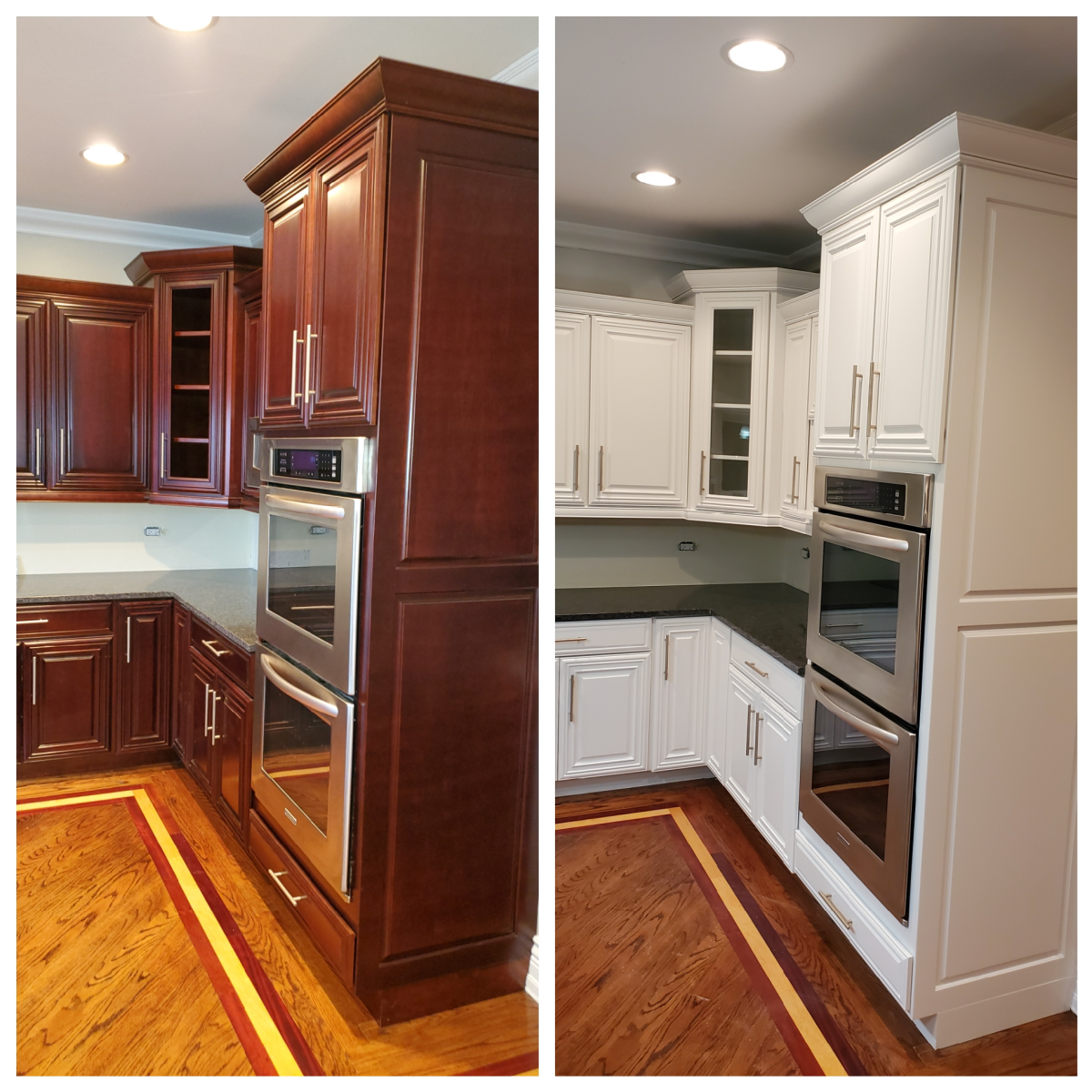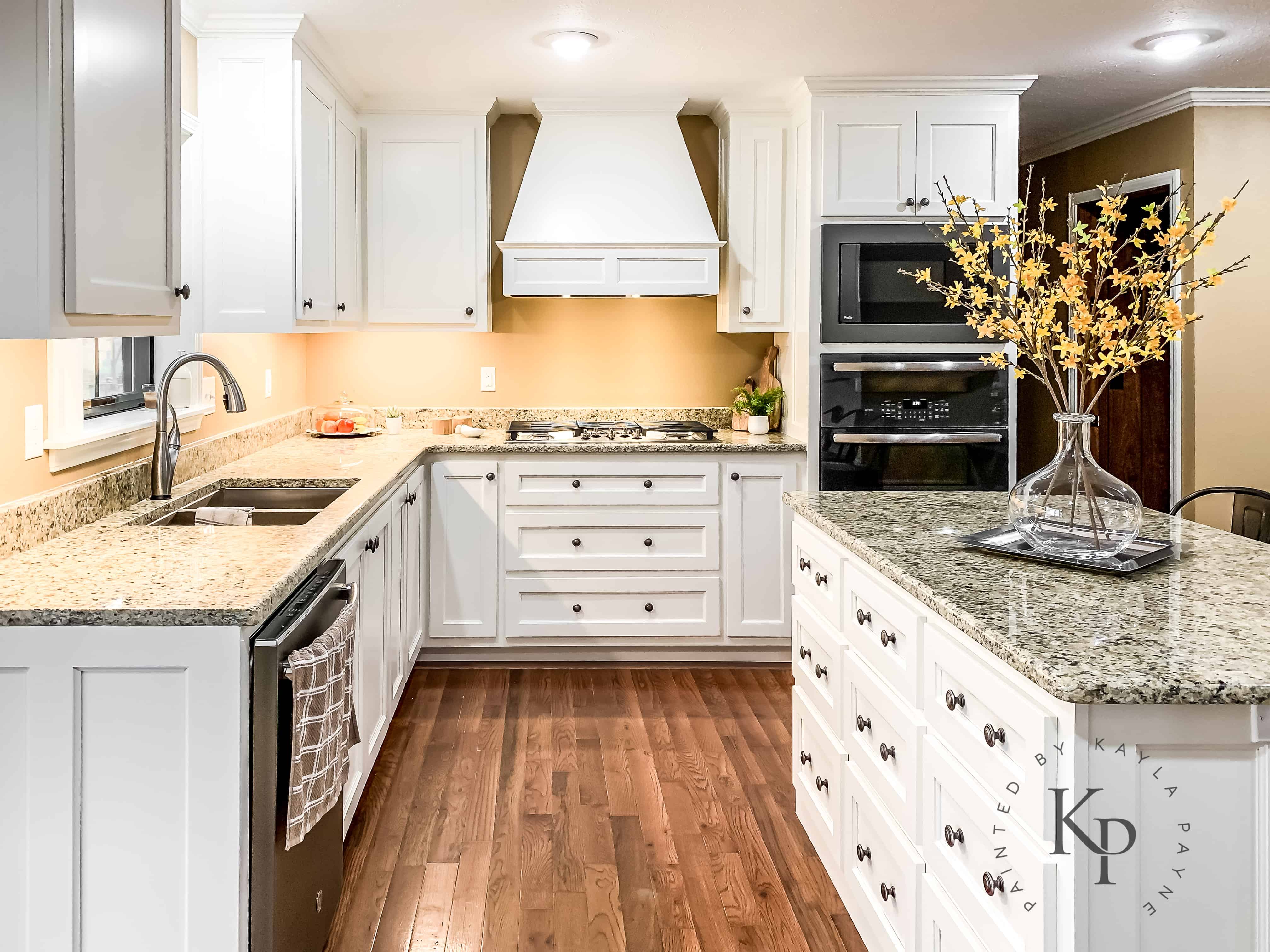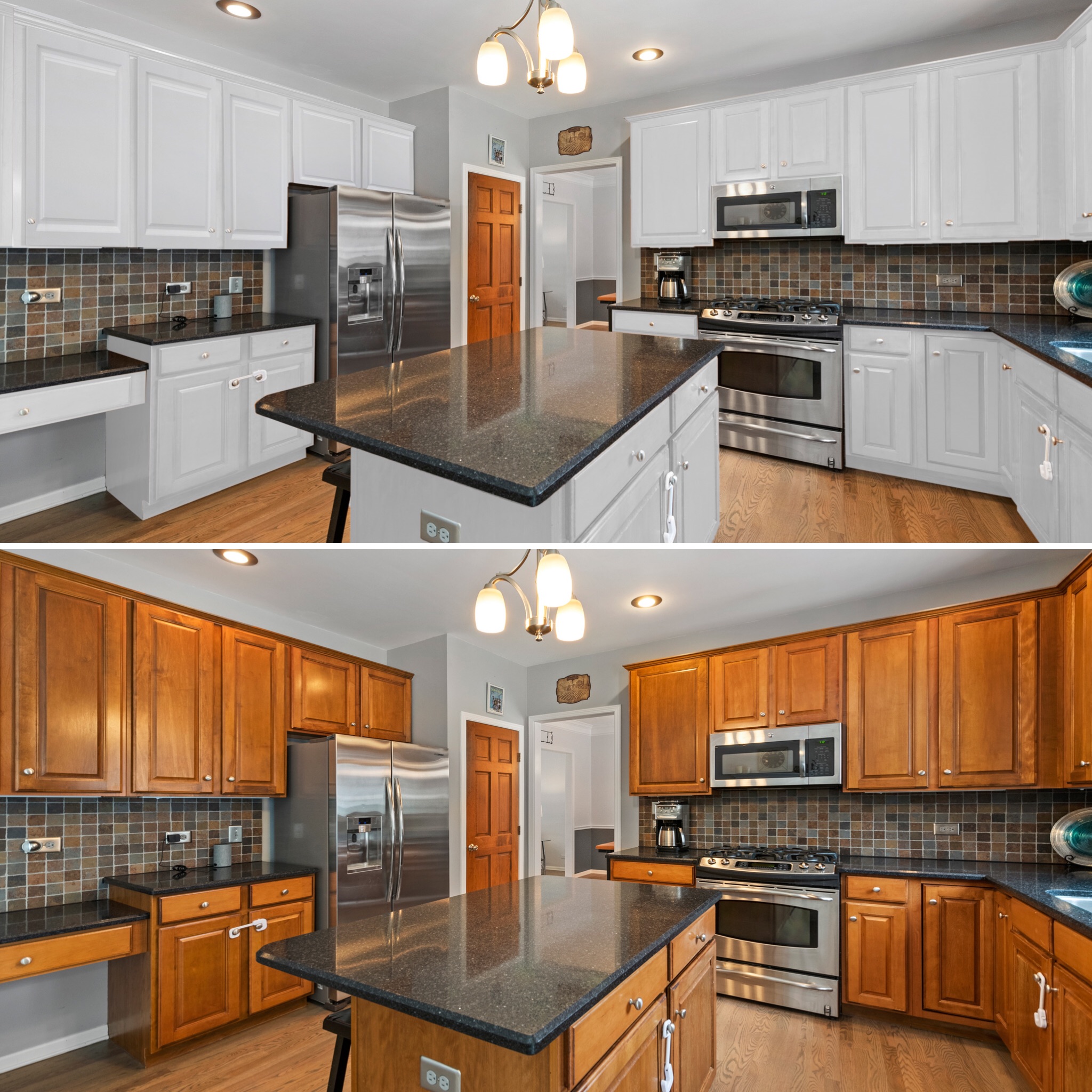Why Repaint Kitchen Cabinets White?

Repainting your kitchen cabinets white can be a transformative project, offering a range of benefits that enhance both the aesthetics and functionality of your kitchen. White cabinets have a unique ability to elevate the overall look and feel of a space, making it appear larger, brighter, and more inviting.
Brightening and Enlarging a Space
White is a light-reflecting color, and this characteristic plays a significant role in how it impacts a kitchen’s ambiance. White cabinets can make a small kitchen feel more spacious by reflecting natural light and creating a sense of openness. The lightness of white visually expands the space, minimizing the feeling of confinement often associated with smaller kitchens. This effect is particularly noticeable in kitchens with limited natural light, where white cabinets can significantly brighten the space, creating a more airy and welcoming atmosphere.
Creating a Clean and Timeless Aesthetic
White cabinets are known for their ability to create a clean and timeless aesthetic. Their neutrality allows them to blend seamlessly with various design styles, from modern and minimalist to traditional and farmhouse. This versatility makes white cabinets a popular choice for homeowners who want a kitchen that is both stylish and enduring. The clean, uncluttered look of white cabinets also helps to create a sense of order and tranquility, contributing to a more relaxed and enjoyable kitchen experience.
Examples of White Paint Colors and Their Effects on Kitchen Design
The world of white paint offers a spectrum of shades, each with its own unique character and ability to influence the overall mood of a kitchen. Here are some examples of popular white paint colors and their effects:
- Pure White: A classic choice that offers a crisp, clean, and bright aesthetic. It reflects the most light, making it ideal for small kitchens or those with limited natural light.
- Creamy White: A warm and inviting shade that adds a touch of softness to a kitchen. It can create a cozy and inviting ambiance, especially in kitchens with a traditional or farmhouse style.
- Off-White: A versatile shade that can be used to create a subtle contrast against other elements in the kitchen. It can be paired with darker countertops or backsplashes for a more contemporary look.
- Grayish White: A modern and sophisticated shade that adds a touch of coolness to a kitchen. It can be paired with metallic accents or black hardware for a sleek and contemporary aesthetic.
Preparing for the Repainting Process

Repainting kitchen cabinets is a rewarding project that can dramatically transform the look of your kitchen. However, before you start painting, proper preparation is crucial for a smooth and long-lasting finish. This involves cleaning, sanding, and priming the cabinets to ensure the paint adheres properly and creates a beautiful, durable surface.
Cleaning the Cabinets
Cleaning the cabinets thoroughly is essential to remove any grease, dirt, or grime that can interfere with the paint’s adhesion. This step ensures a clean surface for the primer and paint to bond to, preventing peeling or chipping.
- Use a mild detergent and warm water to wash the cabinets. Avoid harsh chemicals that could damage the cabinet surfaces.
- Use a soft cloth or sponge to gently scrub the cabinets, paying attention to corners and crevices.
- Rinse the cabinets thoroughly with clean water and allow them to dry completely before proceeding to the next step.
Sanding the Cabinets
Sanding the cabinets is crucial for creating a smooth surface and ensuring the paint adheres properly. It helps remove any imperfections, such as scratches, bumps, or uneven surfaces, and provides a better base for the primer and paint.
- Use fine-grit sandpaper (120-180 grit) to smooth out any rough spots or imperfections.
- Sand the cabinets in the direction of the wood grain for a consistent finish.
- Use a tack cloth to remove any dust or debris after sanding.
Priming the Cabinets
Priming the cabinets is essential for creating a uniform surface for the paint to adhere to. It helps seal the wood, prevents the paint from soaking into the wood, and provides a smooth base for a consistent paint finish.
- Choose a primer specifically designed for cabinets or wood surfaces.
- Apply the primer evenly using a brush or roller, ensuring complete coverage.
- Allow the primer to dry completely before applying the paint.
Removing Cabinet Doors and Hardware
Removing the cabinet doors and hardware allows for more efficient and thorough painting. This ensures that all surfaces are properly prepped and painted, including the back of the doors and the inside of the cabinets.
- Use a screwdriver or other appropriate tools to remove the cabinet doors and hardware.
- Label the doors and hardware to ensure proper reassembly after painting.
- Store the doors and hardware in a safe place to prevent damage.
Materials Needed for the Project
Having the right materials on hand will make the repainting process easier and more efficient. Ensure you have the following:
- Paint: Choose a high-quality, durable paint specifically designed for cabinets or trim. White paint is a popular choice for kitchen cabinets, as it brightens the space and provides a clean, classic look.
- Brushes: Use a good quality brush for painting the edges and corners of the cabinets. Choose a brush with soft bristles that won’t leave brushstrokes.
- Rollers: A roller is essential for painting large flat surfaces, such as the cabinet doors and sides. Use a roller with a nap length suitable for the paint and surface.
- Tape: Use painter’s tape to protect areas that you don’t want to paint, such as walls, countertops, and backsplashes.
- Drop cloths: Cover the floor and surrounding areas with drop cloths to protect them from paint splatters.
Ventilation and Safety Precautions
Proper ventilation and safety precautions are crucial during the painting process. Paint fumes can be harmful to your health, so it’s important to ensure adequate ventilation and take the necessary safety measures.
- Open windows and doors to provide good ventilation during the painting process.
- Wear a respirator mask to protect your lungs from paint fumes.
- Wear gloves to protect your hands from paint and chemicals.
- Avoid smoking or using open flames during the painting process.
Painting Techniques and Tips: Restaining Kitchen Cabinets White

Applying paint to your kitchen cabinets can be a rewarding experience, resulting in a fresh and updated look. Choosing the right painting technique and following some key tips can significantly enhance the final result. Here, we will explore different methods for applying paint to cabinet doors and frames, and provide advice on achieving a smooth and professional finish.
Brushwork
Brushwork is a classic painting technique that involves using a brush to apply paint. This method offers a high degree of control, allowing for precise application and detailed work.
- Using a high-quality brush, such as a natural bristle brush or a synthetic brush specifically designed for painting cabinets, is essential for a smooth finish.
- Load the brush with a small amount of paint, ensuring that the bristles are evenly coated.
- Apply the paint in thin, even strokes, working in the direction of the wood grain.
- Overlap each stroke slightly to ensure complete coverage and avoid brush marks.
- Avoid pressing too hard on the brush, as this can cause brush strokes and uneven paint application.
Rolling, Restaining kitchen cabinets white
Rolling is a faster and more efficient method for applying paint to large surfaces, such as cabinet doors and frames. It can provide a smooth and even finish, but it requires practice and attention to detail.
- Using a high-quality paint roller, such as a foam roller or a microfiber roller, is recommended for a smooth finish.
- Load the roller with a moderate amount of paint, ensuring that it is evenly distributed across the roller.
- Apply the paint in long, smooth strokes, working in the direction of the wood grain.
- Overlap each stroke slightly to ensure complete coverage and avoid roller marks.
- Avoid pressing too hard on the roller, as this can cause uneven paint application and roller marks.
Tips for Achieving a Smooth and Even Finish
- Prepare the surface thoroughly by sanding, cleaning, and priming. This ensures a smooth and even base for the paint to adhere to.
- Use a high-quality paint that is specifically designed for cabinets. This will ensure durability and a smooth finish.
- Apply the paint in thin, even coats. This allows the paint to dry evenly and prevents drips and runs.
- Allow sufficient drying time between coats. This ensures that the paint is completely dry before applying the next coat.
- Use a light sanding technique between coats to smooth out any imperfections.
- Avoid applying too much paint at once, as this can lead to drips and runs.
- Use a paint brush or roller specifically designed for painting cabinets. This will help to avoid brush strokes and roller marks.
Multiple Coats and Drying Time
Applying multiple coats of paint is crucial for achieving a durable and professional-looking finish. Each coat adds to the depth and richness of the color, while also providing additional protection.
- The number of coats required will depend on the type of paint and the desired level of coverage.
- Allow adequate drying time between each coat, following the manufacturer’s instructions. This ensures that the paint is completely dry before applying the next coat.
- Insufficient drying time can lead to uneven paint application, drips, and runs.
Creating a Professional-Looking Finish
- Using painter’s tape to mask off areas that you don’t want to paint can help create clean lines and avoid paint splatters.
- Using a high-quality paint brush or roller specifically designed for painting cabinets can help achieve a smooth and even finish.
- Applying the paint in thin, even coats, allowing adequate drying time between coats, and using a light sanding technique between coats can all contribute to a professional-looking finish.
Restaining kitchen cabinets white – Restoring your kitchen cabinets to a crisp white finish can completely transform the space. It’s a simple yet effective way to brighten up your kitchen and give it a fresh, modern feel. If you’re looking for inspiration for the rest of your home, consider browsing through the selection of fixer upper bedroom lamps to find the perfect lighting for your bedroom.
The same attention to detail you put into your kitchen cabinets will carry over to the rest of your home, creating a cohesive and stylish look.
While restaining kitchen cabinets white can be a great way to brighten up a space, consider the timeless elegance and functionality of a white oak display cabinet for showcasing your prized possessions. It adds a touch of warmth and sophistication that complements any kitchen design, offering a unique alternative to a simple white paint job.
